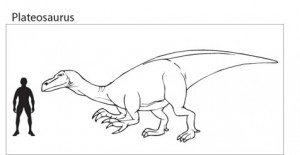Dinosaur Buried Alive – New Dinosaur Species Discovered in Utah Sandstone
New Dinosaur Species Discovered – The Origins of a Native Indian Legend Perhaps?
Researchers reporting in the on line scientific journal PLoS One have described the discovery of a new species of primitive, long-necked dinosaur that was buried in a collapsed sand dune approximately 185 million years ago. The fossil was discovered eroding slowly out of sandstone strata, close to the archaeological remains of an ancient native Indian settlement. Could these bones be the source of the Navajo Indian legend of a sand monster that buried its victims alive in the dunes?
The sandstone block has been partially removed from its burlap and plaster covering. The bones making up the right hand can clearly be seen, the five digits with sharp claws on the end of the fingers. The fossil is articulated and nearly complete with just the skull, some elements of the toes and a shinbone missing. Unfortunately, skull material is often absent with fossils of this nature. The relatively small skull, balanced on a long neck is very often not present when the rest of the fossilised skeleton is discovered.
Seitaad ruessi
The dinosaur has been named Seitaad ruessi. This dinosaur has been named to honour the ancient American Indian sand monster which was known as “Seit’aad”, the species name is in memory of the poet and naturalist Everett Ruess who disappeared in the sandy desert of southern Utah in 1934.
This dinosaur is a member of the Sauropodomorpha, long-necked herbivores with lizard-like feet. It would have been around 3-5 metres long and perhaps over 1 metre high at the hips. It lived during the early Jurassic (Toarcian faunal stage), approximately 185 million years ago. Southern Utah during the early Jurassic was a dry, arid desert environment but with isolated strips of lush and verdant vegetation close to water sources.
Dinosaur
This dinosaur was probably a facultative biped, normally walking on all fours but capable of running or standing just on its hind legs as and when necessary.
The analysis of the fossilised bones was undertaken by palaeontologists Joseph Sertich, a Stony Brook University doctoral student and Mark Loewen of the Utah Museum of Natural History.
Commenting on the discovery, Sertich said in a statement:
“Although Seitaad was preserved in a sand dune, this ancient desert mush have included wetter areas with enough plants to support these smaller dinosaurs and other animals.”
Although, Sertich went onto add:
“Just like in deserts today, life would have been difficult in Utah’s ancient sand sea.'”
The fossil was discovered in 2004 and removed from the sandstone cliff the following year. It is likely that more work will be carried out on the matrix that contains the fossil so that more of the skeleton can be revealed.
This particular discovery helps to confirm the success of the Sauropodomorpha in the Early Jurassic, this type of dinosaur was relatively common and would have made up some of the larger elements of the mega fauna on the super-continent of Pangaea.
The research team have stated that they believe that this particular dinosaur was unfortunate to have been buried suddenly in a collapsing sand dune, perhaps the sand was disturbed as a herd of these animals moved across the landscape. This dinosaur was engulfed and the remains ended up stood on their head.
Plateosaurus
Perhaps the best known Sauropodomorpha is Plateosaurus (prosauropod), one of the best known dinosaurs of all. Many thousands of plateosaur fossils have been found in Europe. It was clearly one of the most common types of dinosaur in the Late Triassic.
An Illustration of Plateosaurus
Picture credit: Everything Dinosaur
To view models of Plateosaurus and other Sauropodomorpha members: CollectA Prehistoric Life Models.


